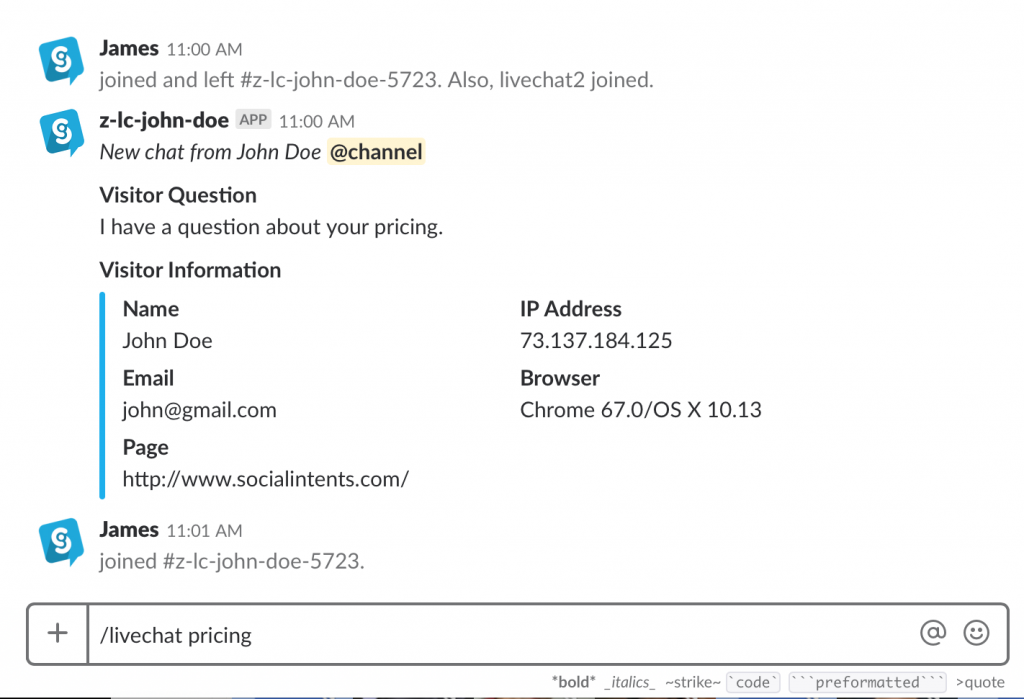You’ve installed live chat but now you realize that you don’t have a playbook for interacting with your customers in this way.
A lot can go wrong here. Long wait times, miscommunication, and the wrong tone of voice can turn a curious lead into an annoyed one, and an existing customer into someone who is contemplating moving to the competition. Not to mention that it will kill the morale of your customer support agent.
How do you make sure to exceed your users’s expectations? To make a good impression and increase your sales while you’re at it?
By following the 13 essential live chat etiquette rules we outline below. These are designed to ensure customer satisfaction.
What Is Live Chat Etiquette?
Chat etiquette for customer service refers to a set of rules that guide how support teams interact with website visitors during live chat conversations.
With 60% of customers saying they are more likely to revisit a website if it offers live chat, the potential for better customer engagement with this widget is clear. However, simply having live chat available isn’t enough to guarantee repeat visits.
These guidelines aim to ensure that each support agent consistently provides exceptional customer service, ultimately leaving the customer feeling valued and understood.
13 Live Chat Etiquette Tips
Incorporate the following chat etiquette rules into your marketing strategy:
1. Don’t keep the customer waiting
Let’s face it: nobody — especially not angry or frustrated customers — likes to wait for a response.
First response time is, and always will be, among the most important live chat metrics. Prompt responses demonstrate to customers that their issues are important and being addressed quickly.
However, your job doesn’t end at an instant first response.
Customer service agents must also be able to handle all conversations without much delay. Long hold or wait times during interactions with support teams are a primary cause of bad customer service experiences.
On average, consumers have to wait 2 minutes and 40 seconds to get the first response from a live chat agent, while a typical user expects a response in under a minute.
This is why quick responses are a must to boost customer satisfaction.
Here are a few tips to reduce waiting periods:
- Implement a chatbot: A chatbot can reduce live chat requests by handling common queries instantly.
- Integrate Social Intents: With Social Intents, your live chat support team can interact with customers directly from Slack or Microsoft Teams — two of the most commonly used internal communication platforms. This integration allows support agents to accept chat requests from related channels or groups on a platform they always have open, ultimately leading to faster response times from available chat operators.
- Recruit new agents: If the current team cannot handle all chat requests on time, you should consider introducing new live chat agents.
- Use canned responses: Canned messages are pre-written replies to common questions that can reduce the average response time during live chat sessions. For example, if you frequently receive the question, “Will Social Intents slow down my site?” you can use a canned response like: “Social Intents will not slow down your site. It loads in the background (asynchronously), so it doesn’t interfere with or delay your website’s loading speed.”

By implementing these strategies, you can significantly reduce waiting periods, enhance the efficiency of your live chat support, and provide exceptional customer service.
2. Start with a friendly greeting
First impressions matter. So, why not start a chat interaction with a welcoming message that sets a positive tone from the start?
One in three people say that talking to a friendly and knowledgeable representative is the most important part of a good customer service experience.
An ideal chat conversation begins with a welcoming, context-driven greeting. Here are a couple of examples:
- Proactive message for new customers: “Hey [First Name], welcome on board! I’m here to assist you with anything you need!”
- Greeting based on the page: Use proactive triggers to greet visitors based on the page they’re on. For instance, “New here? Feel free to look around and just say ‘hi’ if you need any help!” is a great greeting for first-time visitors.
Here are some general tips for crafting a friendly greeting:
- Be courteous and professional: Always maintain a polite and professional tone.
- Tailor the first message to the situation: If the customer has encountered issues, it’s good to apologize right away. For example, “I’m sorry you’ve had trouble with our product/service.”
- Show empathy: If it’s a complaint, start with something like, “I understand how frustrating this must be for you…”
- Express gratitude: Thank the customer for their patience if there was a delay in connecting.
- Use their name: Customizing the greeting with the user’s name makes the interaction more personal and engaging.
3. Humanize your chat support
A friendly conversation looks less personal if you don’t seem human enough. To humanize chat support:
- Visible profile and designation: Make your profile picture and designation visible to the customer. Ensure that your chatbot is not masked as a customer service agent.
- Introduce yourself: Start with a personal introduction. For example, “Hey [First Name]! It’s Pawel from Social Intents. I’ll be assisting you with your [Problem Category] problem(s) today.”
- Use emojis: Incorporate emojis to add a friendly touch. For instance, “Hey, I will be assisting you today.” is bland compared to “Hey! I will be assisting you today :)”.
- Add humor: Use humor appropriately to add a human touch. This can include telling a light joke, sharing a relevant meme, or replying with a funny GIF. However, it’s essential to gauge the situation and the customer’s sense of humor before doing so.
4. Use active listening
Most people do not listen with the intent to understand; they listen with the intent to reply.” – Stephen Covey.
Unlike passive listening, where one might hear the words without engaging with the speaker, active listening requires deliberate effort to process and respond to the message effectively.
This invaluable skill makes customers feel heard, helps agents understand their queries thoroughly, and enables precise responses.
Here are a few tips to enhance your active listening and reading skills:
- Focus on the customer’s initial query: Pay close attention to the customer’s initial message. If needed, ask for clarification and take time to review it carefully.
- Address multiple questions individually: If the customer asks multiple questions, make sure to answer each one separately.
- Avoid interrupting: If someone is writing a longer sequence of messages, addressing only the initial points can disrupt the flow of the conversation. To prevent this, Social Intents offers a live typing preview feature that allows you to see messages as they are being typed.
- Reserve judgment: Do not judge the customer’s questions or concerns. What seems obvious to you may not be to them, so approach each query with patience and understanding.
5. Maintain a positive tone throughout the entire conversation
Maintaining a positive tone throughout the conversation is an essential part of customer service chat etiquette.
Use positive phrases and avoid negative ones, as these can significantly impact the customer’s experience. Here are some examples:
Instead of saying:
- “Sorry for the delay.”
- “We don’t have that.”
- “Our engineer is not available right now.”
- “Don’t forget to…”
Use:
- “Thanks for your patience 🙂”
- “It’ll be available in [N] days. I’ll let you know through email when it’s available.”
- “Kindly wait for a couple of hours for our engineer to resolve it.”
- “Remember to…”
General tips for positive language:
- Refrain from using negative words such as ‘not,’ ‘can’t,’ ‘mistake,’ ‘failure,’ ‘terrible,’ ‘stupid,’ etc.
- Opt for positive alternatives like ‘thanks,’ ‘kindly,’ ‘please,’ ‘for sure,’ etc.
By consistently speaking in a positive manner, you create welcoming and professional chat interactions that leave customers feeling valued and understood.
6. Apologize sincerely
Maintaining a positive tone and taking accountability are two different things.
If the customer is facing an issue due to your company’s mistake, it is crucial to offer a sincere apology.
For instance, “Thanks for your patience :)” is appropriate if there is a minor delay in response. However, for a more serious issue like a shipping delay, a better message would be: “Hi [First Name], we apologize for the delay. I understand it’s frustrating…”
How to make your apology sincere:
- Express genuine regret: Show that you are truly sorry.
- “I’m really sorry for the inconvenience this has caused.”
- Explain the issue: Provide a brief explanation of what went wrong.
- “There was an unexpected delay in our shipping process.”
- Assure future improvement: Let the customer know how you will prevent this issue in the future or how you are addressing it now.
- “We are implementing new measures to ensure this doesn’t happen again. Your order is now being prioritized, and we will keep you updated on its status.”
By following these steps, you can convey a sincere apology that acknowledges the mistake, explains the situation, and reassures the customer of future improvements. This approach not only resolves the immediate issue but also helps rebuild customer loyalty and trust.
7. Keep your messages short and simple
Customers expect to find answers and solutions to their questions and problems. They don’t want to read lengthy explanations, open dictionaries, or frequently ask, “Sorry, can you explain what that means?”
Keeping your messages concise is an essential aspect of live chat etiquette. Here are a few tips for better live chat communication:
- Use short sentences: Keep your sentences brief and to the point to ensure clarity.
- Avoid technical jargon: Do not use technical terms or complex words that the customer might not understand.
- Use analogies and metaphors: Simplify complex ideas by using relatable analogies and metaphors.
- Stay on topic: Focus on addressing the customer’s issue directly to save time for both parties. While it’s good to create rapport, customers ultimately seek solutions.
By following these guidelines, you can provide clear and efficient support that meets customer expectations without overwhelming them with unnecessary information.
8. Write conversationally
To customers, a formal written message can feel robotic and impersonal. As mentioned in Tip #3, we want to humanize our chat support by making our messages friendly and approachable.
Writing conversationally gives the interaction a more relatable and warm tone. Here are some tips to make your messages more conversational:
- Use short sentences: Short sentences mirror natural speech. For example, “You see what I mean?”
- Use contractions: Instead of “I will” or “you are,” use “I’ll” and “you’re.”
- Address the reader: Speak directly to the customer by using “you” and their first name wherever possible.
By adopting these techniques, you can make your live chat interactions feel more personal and engaging for your customers.
9. Watch out for grammar and spelling errors
While it’s important to maintain a friendly tone, it’s equally crucial to remember that you are a professional whose duty is to assist the customer. One of the basic requirements of being a support agent is maintaining correct grammar, spelling, and punctuation.
To ensure your messages are error-free, consider using tools like Grammarly or ProWritingAid. These tools can help you avoid common mistakes and maintain a high level of professionalism in your communications.
By balancing friendliness with professionalism, you can provide effective and polished customer support.
10. Implement proactive support
Quickly reviewing previous conversations the customer has had with the support team can help you understand the situation better and save the customer the effort of repeating themselves.
For example, if the customer has already sent an email asking the same question but hasn’t received a reply, acknowledge that and apologize.
Example: “Hi [First Name], I see you’ve emailed us about this issue before and haven’t received a response. I’m sorry for the delay, and I’m here to help you resolve it now.”
Note: Using proactive live chat to engage website visitors is also beneficial. For instance, setting up triggers to greet visitors based on their behavior on your site can lead to more personalized and timely support.
By being proactive, you can provide a more efficient and personalized service, enhancing the overall customer experience.
11. End on a high note
People remember last impressions even more than first impressions, especially when it is your job to solve an issue. Here are some messages you can use at the end of a successful conversation to make a positive impact:
- “Thank you for your patience. I’m glad I could help you today :)”
- “Thanks for choosing us. We hope you’re satisfied with our service.”
- “Please let me know if there’s anything else I can assist you with.”
- “Feel free to contact us anytime. We’re here to help 24/7/365 :)”
- “Have a great day!”
By using these types of messages, you can leave a lasting great impression and reinforce a sense of support and professionalism.
12. Collect feedback
Gathering customer feedback is perhaps the most crucial aspect of chat etiquette. By asking customers to fill out a form or survey, you can measure:
- Customer Satisfaction Score (CSAT): How satisfied customers are with their interaction.
- Net Promoter Score (NPS): How likely customers are to recommend your service to others.
- Customer Effort Score (CES): How easy it was for customers to get their issues resolved.
By collecting and analyzing this customer feedback, you can identify areas for improvement and work towards enhancing the overall customer experience, aiming to uplift your average scores in these metrics.
13. Keep your promises
All the live chat etiquette tips will be ineffective if you break this fundamental rule.
When live chat agents promise to resolve a customer’s issue and fail to follow through, it creates a poor customer experience. This can be more damaging than almost any other misstep.
Honesty and realistic commitments are crucial. For example, if a customer asks for delivery by a specific date and you guarantee it, you must ensure it happens — even if it means taking a loss by paying extra for express shipping.
A single bad experience and negative word of mouth can harm your company more than a slight financial loss. Keeping promises fosters long-term customer loyalty, making it essential to uphold this aspect of chat etiquette.
Perfect Your Live Chat Strategy With Professional Chat Etiquette
Mastering your live chat etiquette is vital for delivering outstanding customer service.
Each live chat session is an opportunity to build trust, resolve issues efficiently, and leave a lasting positive impression.
By following these 13 customer service etiquette tips — from starting with a friendly greeting and maintaining a positive tone to being proactive and keeping promises — you can transform your customer interactions.
Social Intents offers live chat software that makes it easy to follow your brand’s chat etiquette. With features like live typing preview, proactive chat invites, and seamless integrations with communication tools, you can quickly improve response times and create memorable customer experiences.
Get started with our 14-day free trial now.


